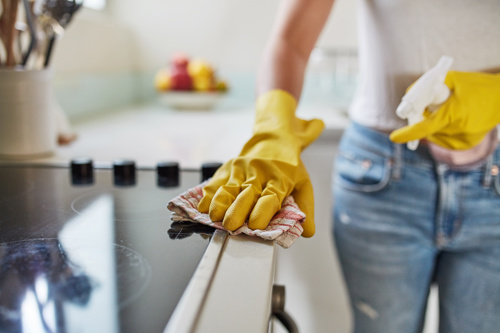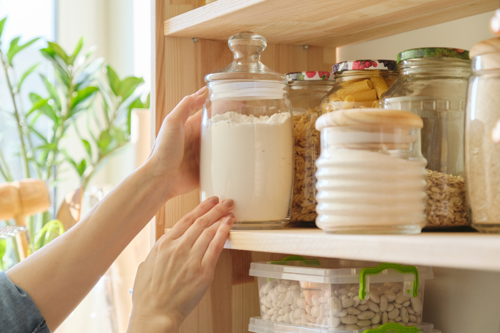You don’t have to line your roof with solar panels to make your home more eco-friendly. In fact, tweaking your lifestyle to be “greener” can actually be hassle-free and inexpensive. By making a few small adjustments to your space, you can reduce your carbon footprint in significant ways. Here, we’ll share our 10 favorite home hacks that are better for the environment.
- Shop Vintage/Thrift or DIY
- Use Eco-Friendly Home LED Lights
- Wash Your Clothes With Cold Water
- Start Composting
- Use Fewer Paper Towels
- Make Your Own Eco-Friendly Home Cleaning Products
- Switch Off Your Electronics
- Buy Essentials in Bulk and Store in Glass
- Regulate Temperatures With a Smart Thermostat
- Opt for Eco-Friendly Landscaping
1. Shop Vintage/Thrift or DIY
Your wardrobe and furniture don’t have to be 100 percent thrifted — even replacing a portion of your home with vintage finds can be beneficial for the environment. With 60 percent of clothes constructed from synthetic materials such as polyester, nylon and acrylic that will end up in a landfill, buying pre-loved items can reduce textile waste and divert your money from toxic cotton plants that are polluting both water and air. With a bit of luck, you can actually find durable, timeless pieces for your closet or your living room at vintage shops, or work a little DIY magic to spiff them up.
| Tip: Before making a clothing purchase (even if it’s secondhand), take a look at your existing wardrobe. Are there new ways you can style your clothes? Lotte, a virtual styling service with a mission to reduce irresponsible consumption, offers one-on-one sessions that can help you rekindle your relationship to pieces that already exist in your closet. |

2. Use Eco-Friendly Home LED Lights
Compared to incandescent bulbs, LEDs have been shown to use 75 percent less energy and last up to 25 times longer. In fact, studies predict that the widespread use of LEDs by 2027 could save around 30 billion dollars a year, by today’s prices. Looking for more reasons to swap out your current bulbs? LEDs emit little heat, reduce light pollution, are less likely to break and don’t attract insects. If you’re looking for a great brand, EcoWatch named Sylvania LED bulbs the best LEDs on the market based on affordability, reviews and other factors. You can grab a 24-pack of standard soft white LEDs for just $26.50* on Amazon.
3. Wash Your Clothes With Cold Water
According to the U.S. Department of Energy, around 90 percent of the energy it takes to wash your clothes actually comes from the water-heating process. So the next time you do a load of laundry, crank the dial to cold. In the long run, it’ll save energy by putting less pressure on electricity grids, lower your utilities, and help your clothes retain their color, size, and shape. If you find that your usual detergent isn’t dissolving the way in cold water, opt for a liquid detergent instead. (Bonus points if you line dry your clothes, too!)
| Have items that can only be dry cleaned? Look for “green cleaners” near you — i.e., dry cleaners that avoid the use of perchloroethylene (perc), a solvent that can harmful to your health and the planet. |
4. Start Composting
You’re probably already aware of the benefits of recycling, but starting your own compost pile is the next step toward a more eco-friendly house. In fact, composting is a practical way of reducing waste and turning your kitchen and yard scraps into a healthy nutrient source for your soil and lawn, as opposed to sending them off to a landfill. This, in turn, lowers methane emissions. If you can’t set up an outdoor bin and are worried that indoor composting will stink up your apartment or house, don’t fret — a properly set-up compost bin does not emit an odor. Check out this guide to learn how to set up a no-scent composting bin in your home. You can also order an electric indoor composter — such as the Lomi — that turns your food scraps into dirt that you can use for indoor and outdoor plants alike.
Purchase the Lomi for $499* on its website.

5. Use Fewer Paper Towels
Paper towels are a home necessity, but more often than not it’s easy to scale back on the number of sheets you use. Instead of relying on a roll for small kitchen spills, for instance, start using cloth towels that you can toss in the wash. (In fact, if you have old T-shirts lying around, now’s the perfect time to grab a pair of scissors and transform them into clean-up rags!) You can also use reusable dinner linens instead of napkins, or save a stash of takeout napkins to use at meals.
6. Make Your Own Eco-Friendly Home Cleaning Products
Cleaning products are important to keeping your house free of dust, allergens, bacteria, mold and more, but many all-purpose sprays can give off toxic fumes that can be harmful to you and the environment. Since many store-bought products may be marketed as “clean” or “natural” but still contain irritating chemicals, it’s best to make your own DIY cleaner. With common household items like white vinegar, lemon, essential oils, rubbing alcohol, and baking soda, you can make a host of products suited for windows, counters, laundry, and more. Check out 10 eco-friendly cleaning solution recipes you can make today.
7. Switch Off Your Electronics
Small appliances like chargers or entertainment centers and larger “energy vampires” like your air conditioning and heating system can siphon hundreds of dollars worth of electricity every year. While some appliances (such as your refrigerator) must be left running, take note of any dormant electronics that you leave on even when you’re not using them. It’s best to get in the habit of powering them off or unplugging them. Getting a power strip can make it easy to turn off an entire section of appliances with a single switch.

8. Buy Essentials in Bulk and Store in Glass
A single trip to the grocery store can bring a lot of unnecessarily plastic into your house — plastic that isn’t always recyclable. Even when it is, studies indicate that only one to three percent of plastic grocery bags are actually recycled every year. While it isn’t likely that you’ll be able to eliminate all single-use plastics in your home, you can opt for more environmentally friendly alternatives instead. During your next trip to the grocery store, check for bulk bins. Bring your own reusable produce bags, Mason jars and totes. Since the average family accumulates up to 60 plastic bags in four grocery trips, doing so will prevent both plastic and paper waste, and, as an added benefit, make it easier for you to organize your kitchen.
9. Regulate Temperatures With a Smart Thermostat
A smart thermostat can do more than just monitor your heating and cooling. As Jennifer Pattison Tuohy writes in her Wirecutter review of the best smart thermostats, the handy tool can learn your schedule, shut itself off when nobody is home and use tiny remote temperature sensors to identify specific areas of your home that are either over- or under-cooled and heated. All of this helps balance temperatures throughout your house and saves you energy (and money) in the process. Tuohy’s choice is the Google Nest Learning Thermostat, which you can snag for $249* (or save $50 when buying two).
| Tip: Check out our guide for the best technologies to make your home “smarter.” |
10. Opt for Eco-Friendly Landscaping
As climate change leads to greater droughts and unpredictable shifts in weather, making wise climate-appropriate landscaping choices can help conserve water without forcing you to compromise on your front yard aesthetics. Whether you opt for slow-growing, drought-tolerant native plants (xeriscaping), leave grass trimmings on your yard to decompose and nourish the soil (grasscycling) or pay attention to erosion control, work with a landscaper who can help you close any loops and make your landscaping vision as sustainable as possible.
| Doing your own landscaping? Check out 7 practical tips — ranging from creating a focal point to texturizing — on our blog. |
*Prices accurate at the time of writing.









